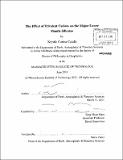The effect of trivalent cations on the major lower mantle silicates
Author(s)
Catalli, Krystle Carina
DownloadFull printable version (12.89Mb)
Other Contributors
Massachusetts Institute of Technology. Dept. of Earth, Atmospheric, and Planetary Sciences.
Advisor
Sang-Heon Shim.
Terms of use
Metadata
Show full item recordAbstract
I have investigated the effect of composition, especially ferric iron and aluminum, on the equations of state and phase stability of perovskite and post-perovskite. The presence of trivalent cations decreases the bulk modulus of perovskite at pressures corresponding to the upper lower mantle. Ferric iron in perovskite undergoes a spin-pairing transition from the high spin state to low spin in the octahedral site. Ferric iron in the dodecahedral site remains high spin. In the absence of aluminum, the spin transition is gradual between 0 and 55 GPa, and bulk modulus increases at the completion of the spin transition. In the presence of aluminum, there is an abrupt increase in the amount of low spin ferric iron near 70 GPa, likely the result of site mixing. The high compressibility of the structure below 70 GPa results in the volume nearing that of magnesium endmember, MgSiO₃ , perovskite. Concurrent with the spin transition in aluminum-bearing perovskite, the structure stiffens. The increase in density and bulk modulus at -70 GPa results in an increase in bulk sound speed that may be related to heterogeneities in bulk sound speed observed seismically at 1200-2000 km depth in the Earth. The effect of composition on the perovskite to postperovskite phase transition was also investigated. No change in the spin state of ferric iron was found at the perovskite to post-perovskite phase transition: ferric iron is low spin in the octahedral site and high spin in the dodecahedral site. At the phase transition, ferric iron only slightly broadens the perovskite plus post-perovskite mixed phase region while ferrous iron and aluminum were each found to significantly broaden the mixed phase region to hundreds of kilometers thick. The effect of background mineral phases was assessed for a basaltic system, rich in aluminum. The coexisting minerals were found to significantly reduce the effect of the aluminum, producing a boundary that is potentially sharp enough for seismic detection in silicon-rich systems, such as basalt.
Description
Thesis (Ph. D.)--Massachusetts Institute of Technology, Dept. of Earth, Atmospheric, and Planetary Sciences, 2011. Cataloged from PDF version of thesis. Vita. Includes bibliographical references (p. 151-165).
Date issued
2011Department
Massachusetts Institute of Technology. Department of Earth, Atmospheric, and Planetary SciencesPublisher
Massachusetts Institute of Technology
Keywords
Earth, Atmospheric, and Planetary Sciences.